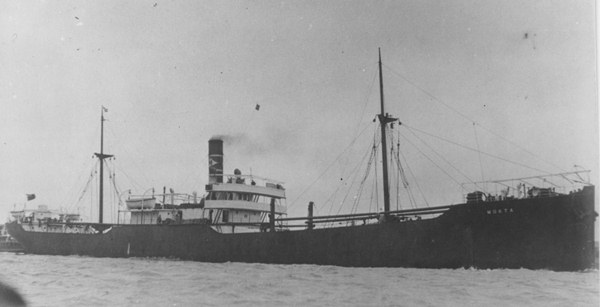Everalda
Latvian Steam merchant

Everalda under her former name Mokta. Photo courtesy of Harold Appleyard
| Name | Everalda | ||
| Type: | Steam merchant | ||
| Tonnage | 3,950 tons | ||
| Completed | 1912 - W. Gray & Co, West Hartlepool | ||
| Owner | MME Zenija Heinrichsons (Fricis Grauds), Riga | ||
| Homeport | Riga | ||
| Date of attack | 29 Jun 1942 | Nationality: | |
| Fate | Sunk by U-158 (Erwin Rostin) | ||
| Position | 31° 00'N, 70° 45'W - Grid DC 5626 | ||
| Complement | 36 (0 dead and 36 survivors). | ||
| Convoy | |||
| Route | Philadelphia – Cape Henry (27 Jun) – Rio de Janeiro | ||
| Cargo | General cargo | ||
| History | Completed in November 1912 as British Mokta for La Tunisienne SN Co Ltd (F.C. Strick & Co), Swansea. 1932 sold to Latvia and renamed Everalda. When Latvia was annexed by the Soviet Union in 1940, she was one of eight ships that did not follow the orders to return home and continued to sail under the Latvian flag. U-boats sank five of these eight ships and damaged a sixth while another one was sunk by an Italian submarine. | ||
| Notes on event | At 17.45 hours on 29 June 1942, U-158 began shelling the unescorted and unarmed Everalda (Master Janis Martinsons) from her starboard beam while she was steaming on a non-evasive course at 7.5 knots about 360 miles south-southwest of Bermuda. Machine gun fire was directed at the bridge to prevent that distress signals could be sent and succeeded in putting the transmitter out of action. Six rounds from the deck gun, mostly incendiary, were fired at the hull, starting small fires in #1 hold and blowing away the hatches of #2 hold. The chief engineer immediately stopped the engines and the Germans withheld fire for 10 minutes while the crew abandoned ship in two lifeboats. The U-boat then fired nine rounds for the deck gun at the waterline amidships on the port side until 18.10 hours. As the ship showed no sign of sinking and the U-boat had no shells left for the deck gun, a boarding party went on board and opened the bottom valves, causing the ship to sink by the bow at 20.00 hours. The Germans captured secret codes, confidential papers, routing instructions and other important documents like a letter for the consul at Rio de Janeiro and took the master and the Spanish crew member Bernardo Cores Cardama as prisoners on board. The remaining 34 survivors were evenly distributed between the two lifeboats which then set sail to the northwest and were soon separated. In the afternoon on 4 July 1942, both boats were spotted by a US Army bomber on an anti-submarine patrol in position 35°16N/74°55W and 35°20N/75°10W. The unarmed Hall PH-3 flying boat V-183 from USCG Air Station Elizabeth City dropped provisions for one of the lifeboats with 17 occupants about 30 miles east of Cape Hatteras. Shortly thereafter the USN blimp K-7 arrived and directed the patrol boat USCGC CG-466 to their position. The survivors were picked up and later landed at Ocracoke, North Carolina. Two hours later, the same flying boat again dropped provisions for the other lifeboat with 17 survivors and directed the patrol yacht USS Tourmaline (PY 20) to their position to pick them up. They were rescued and landed at Morehead City on 5 July. Rostin reported details about the confidential papers that were discovered aboard the Everalda to the BdU and his lengthy wireless signals were picked up by Allied stations, allowing them to pinpoint the position of U-158 by radio direction finding. In the afternoon on 30 June, a PBM-3C Mariner flying boat (VP-74 USN/P-1, pilot Lt Richard E. Schreder) on anti-submarine patrol from Bermuda was redirected to the area, picked up a radar contact while flying in low clouds and completely surprised the U-boat on the surface by diving out of the sun, dropping two depth charges that detonated directly underneath the stern and caused her to sink immediately, leaving behind a large field of wreckage and oil. All 54 crew members and the two prisoners from Everalda were lost. The Allies were aware that several confidential documents carried by all merchant ships were compromised in this incident and were forced to make great efforts to replace the codes and books that were in use at the time. | ||
| On board | We have details of 36 people who were on board. | ||
If you can help us with any additional information on this vessel then please contact us.
